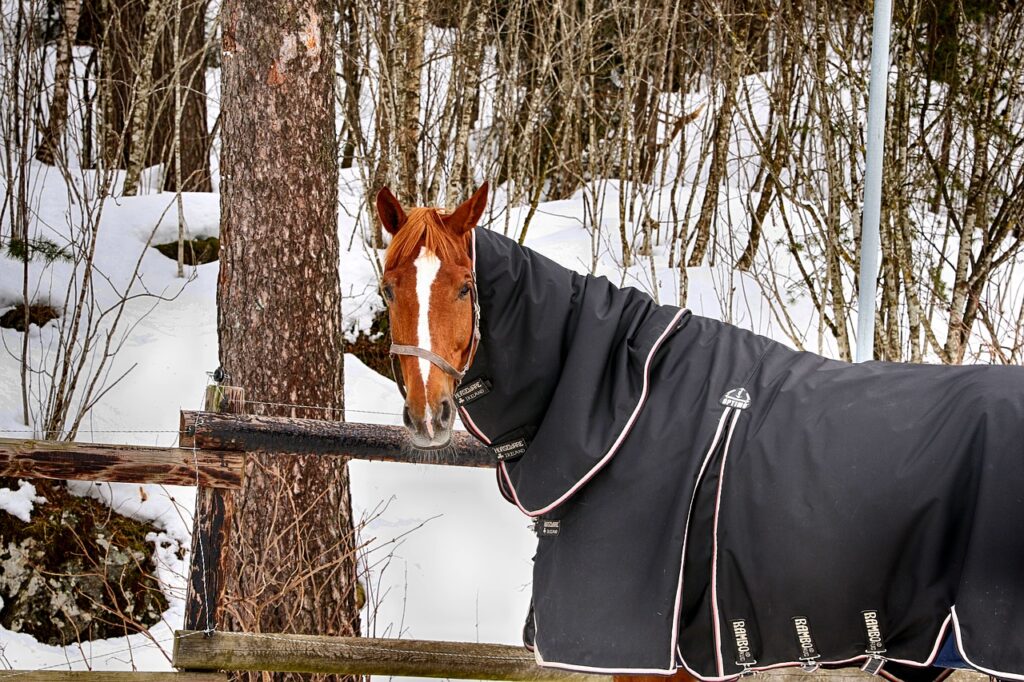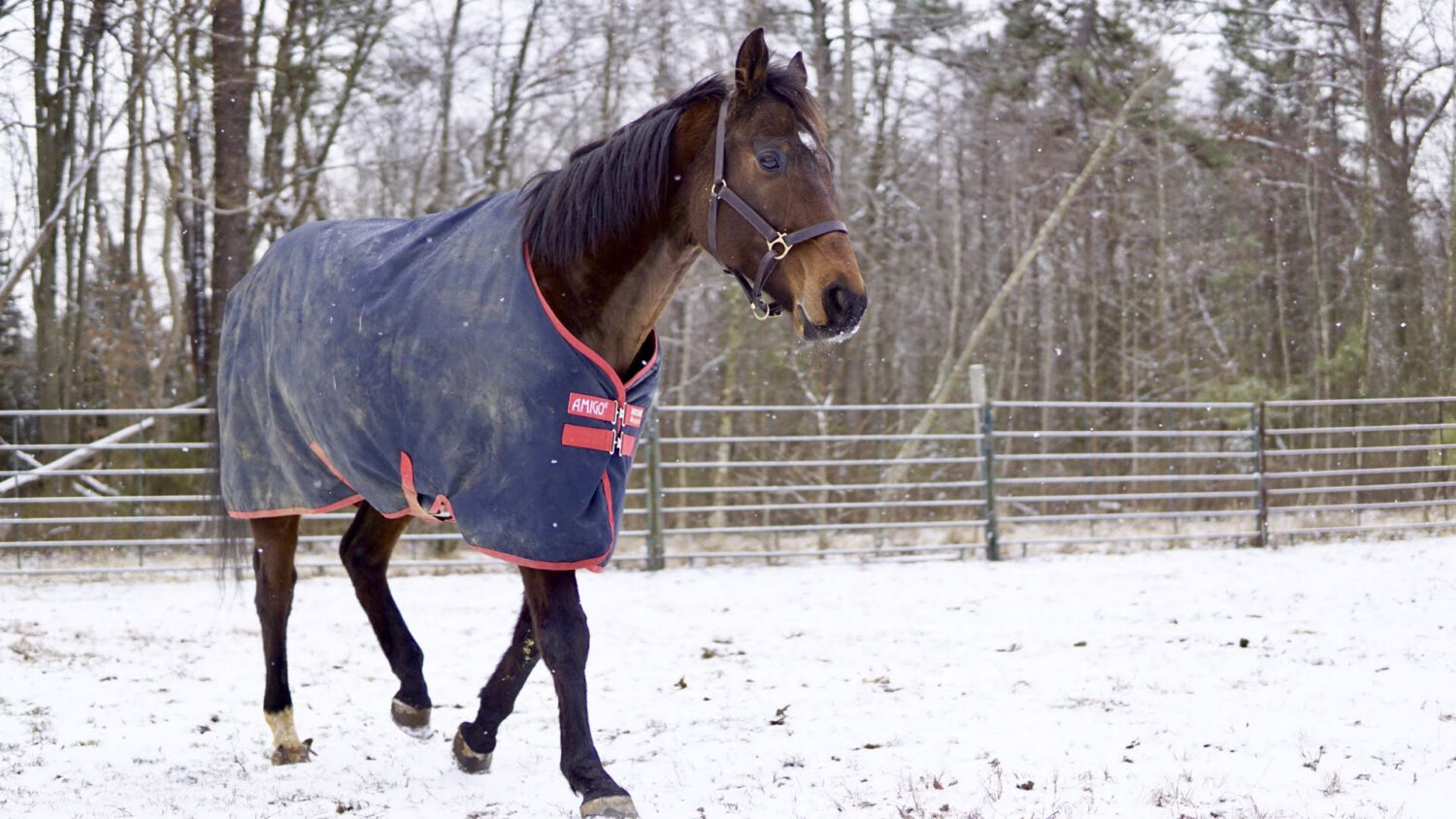When the temperatures start to drop and the snowflakes start to fall… I wait to hear the question.
“It’s getting cold! Do I need to blanket my horse?”
The short and most general answer, if you’re looking for one, is probably not.
It’s easy to think while we’re outside shivering that surely everything else outside must be freezing too. But horses have a few thousand years of evolution and living outdoors in the wild that would seem to prove that many of them are just fine without a blanket regardless of the colder weather.
What To Consider Before Blanketing Your Horse
If you’re debating whether or not you need to blanket your horse you should first understand how your horse is genetically designed to regulate temperate throughout the year. During the late summer months as the days begin to get shorter, horses naturally start producing a winter coat that’s longer and thicker to withstand the colder weather. In addition to their coats, horses also maintain their body temperatures by eating high fiber foods like hay and many barns adjust their feed to compensate for such changes in temperature.
In a 2009 article on The Horse, North Dakota State University Equine Specialist Carrie Hammer, DVM, PhD, said, “Horses have a wonderful ability to survive in the cold… A full winter haircoat is perfect for insulating the horse against the cold winter weather. However, that insulation is lost if the haircoat gets wet. Providing shelter allows the horse to stay dry on wet, snowy days and, ultimately, allows them to stay warm.”
But just because horses are capable of staying warm through the cold doesn’t mean they always do that well. Before throwing the blanket on, here are a few other considerations you should keep in mind.
- Where do you live? Geography matters and how long you’ve spent in the region also plays a role. Generally speaking, blankets are most often needed in northern/colder regions and aren’t as necessary in southern areas. If your horse has lived in your region for a year or more, they’re likely adapted to the climate.
- Does your horse have a winter coat or has he/she been clipped? Horses with a winter coat are obviously a bit better built to withstand colder temperatures while horse’s that are clipped might need to be blanketed sooner at higher temperatures. It’s also worth noting what kind of breed your horse is because some breed like Belgians, Fresians, and Gypsy Vanners grow incredibly thick coats during the colder months.
- Does your horse have access to a stall or run-in shed? Having access to any kind of shelter means that horses can avoid precipitation and wind with ease.
- Is your horse older, sick or thin, or lose weight easily? This is perhaps the most important consideration of them all. What condition is your horse in? The poorer the condition, the more likely you’ll want to blanket.
This Facebook message from the New Brunswick SPCA recently popped up in my Newsfeed and I thought it was worth sharing.
For some people in New Jersey, the sight of an unblanketed horse standing in the snow can be cause for some concern… it shouldn’t be! Keep in mind that there are horses in every corner of the world, in all climates, some of which are still wild, who’ve never seen a blanket and (just guessing here) I’m pretty sure they’re ok with that.
So the Horses Are Probably Fine But Really… When Should I blanket My Horse?
One of the most helpful (and hilarious) blanketing infographics I’ve found to date was produced by Auburn University’s Department of Animal Sciences. Take a look.

You can see from the tangled web of the flowchart that blanketing isn’t something with a hard and fast rule… which is perhaps why there’s so much confusion about when and why to use them.
The truth is that there’s no hard or fast rule because so much relies on your personal preferences and individual situation, like what shape your horse is in and what kind of facility you’re at. Check out this little video from SmartPak’s Ask the Vet series on the subject.
One of the biggest takeaways here is that when you put a blanket on a horse you’re inhibiting that horse’s ability to regulate it’s temperature on its own. That means that you sort of assume a few extra responsibilities when you put on a blanket (in addition to just making sure the thing stays on the horse) like removing the blankets once it gets to warm and checking under the rugs to make sure your horse is comfortable and maintaining weight.
Horse Blankets 101
Blankets were a bit of a mystery to me when I got my first horse because the prices and types varied so widely. I wasn’t sure what I needed or what would work best so let’s review some of what I’ve learned to be rather important when it comes to choosing the best blanket for your horse.
Denier & Weight or Fill
Two words that should stick out when you’re looking at blankets should be denier and fill or weight, usually measured in grams.
Denier refers to the density of the nylon fiber and the numbers associated indicate more or less resilient the fabric will be. The higher the number, like 1200D, the tougher the fabric. Some nylon is also ballistic grade, which is the most durable on the market that I know of.
Blanket weights vary from having loads of fill for extra warmth to none at all in others. This fill is measured in grams and again, the higher the number, the thicker and warmer the blanket will be. Blankets are classified between sheets, which contain 0g of fill, to medium weight, containing between 100g-200g and heavy blankets can range anywhere from 200-400g.
Types of Blankets
If you’ve gotten a grip on how blankets are classified you can start to get an idea of what type of blanket or sheet you might need for your horse and its living situation. But even with the basics there are still a number of different types of blankets you should be familiar with.
Rain Sheets – With 0g of fill, rain sheets won’t do too much in the way of keeping your horse warmer but being waterproof they’ll do a lot to keep horses dry during colder, rainy days. They also are not typically built to withstand a ton of beating and are often made with less dense nylon and aren’t as secure for horses running around a field.
Turnout Sheets – A step up from a rain sheet, turnout sheets are waterproof and made to withstand extended periods of turnout. They generally feature more secure closures and are made with denser fabric, including ballistic nylon that was originally developed for bulletproof vests!
Stable Sheet – A stable sheet is nothing like a turnout sheet or a rain sheet. They are not waterproof but offer a lighter layer of warmth when the horse is in a stall or trailer. Most commonly they’re used to keep a horse’s coat clean on the way to a show or event.
Stable Blankets – As the name might suggest, stable blankets are available with varying levels of fill but they’re not made to withstand the tortures of turnout. Generally they’re made of much softer fabrics, which make them extra comfortable and perfect for layering underneath waterproof sheets for horses that are turned out.
Turnout Blankets – The toughest of blankets in the horse world, turnout blankets contain varying levels of fill and are made of dense fabric to withstand all the snow and playtime your horses can manage.
Some blankets are also available with high necks for those larger, high withered horses, and others can also include neck covers like this chestnut below, some of which may also be detachable.

For any other, more specific blanketing related questions SmartPak also has an INCREDIBLY detailed horse blanketing guide on their website so check it out if you need help with anything else!
Horse Blanketing Tips
You’ve got your blanket, it’s freezing cold out and it’s time to go warm up your pony. Is there anything else you should know? Of course there is! Here are a few extra horse blanketing tips to keep in mind.
Blanket Your Horse Relative to the Daytime High
Before you pick out the heaviest blanket you own, it’s important to take a look at the forecast and base your blanketing decision around the daytime high, especially if you’re not able to visit your horse through the day and make adjustments according to the day’s weather.
Continue Grooming & Ensure Your Horse Is Dry Under The Rug
Just because you throw on a blanket doesn’t mean you get to escape grooming duties entirely. You’ll still want to regularly groom them to encourage healthy hair and skin growth, make sure they’re dry beneath the blanket, and also to check to make sure that they’re maintaining a healthy weight.
How to Correctly Attach Leg Straps
The final piece of the blanketing puzzle, leg straps can be a little misleading for the inexperienced. Take a look at this short video that demonstrates how to properly attach and adjust leg straps.

